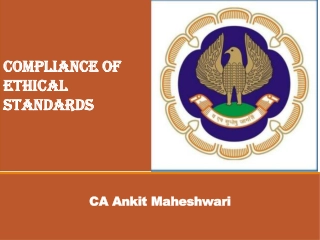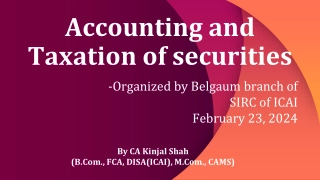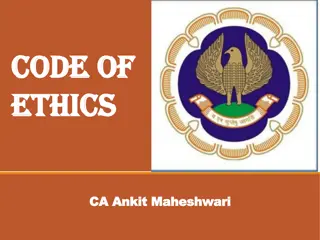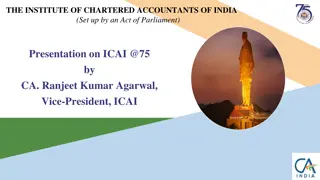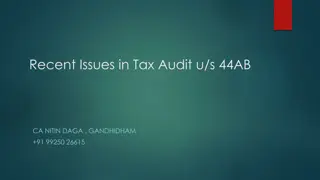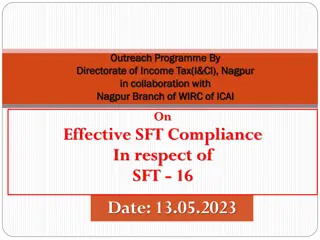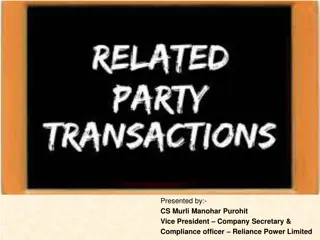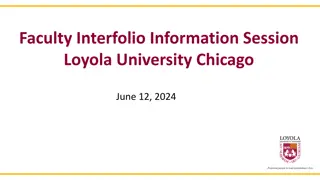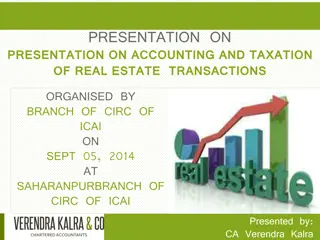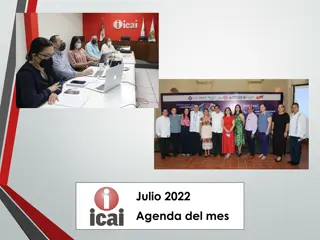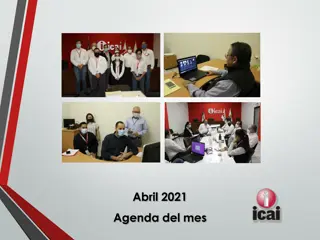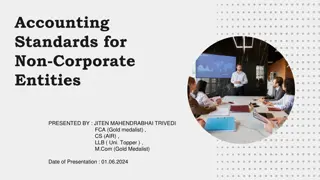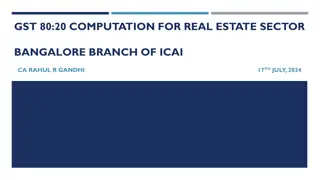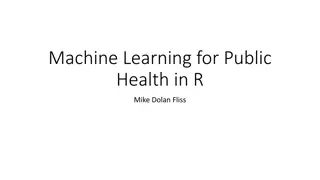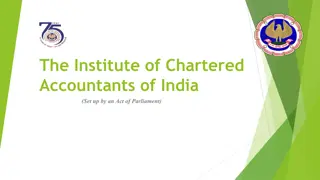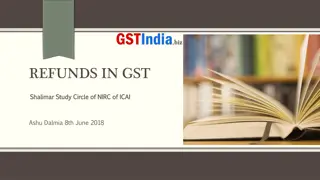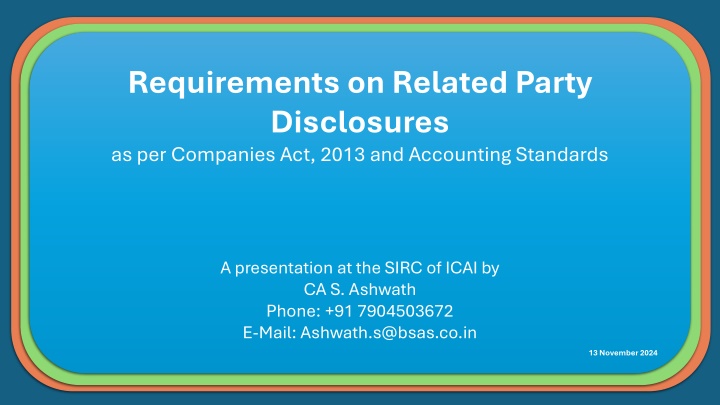
Related Party Disclosures as per Companies Act, 2013
Gain insights into related party disclosures according to the Companies Act, 2013 and Accounting Standards through a presentation by CA S. Ashwath at the SIRC of ICAI. Discover who related parties are, where to find definitions, and explore case studies to deepen your understanding. Contact CA S. Ashwath for more information.
Download Presentation

Please find below an Image/Link to download the presentation.
The content on the website is provided AS IS for your information and personal use only. It may not be sold, licensed, or shared on other websites without obtaining consent from the author. If you encounter any issues during the download, it is possible that the publisher has removed the file from their server.
You are allowed to download the files provided on this website for personal or commercial use, subject to the condition that they are used lawfully. All files are the property of their respective owners.
The content on the website is provided AS IS for your information and personal use only. It may not be sold, licensed, or shared on other websites without obtaining consent from the author.
E N D
Presentation Transcript
Requirements on Related Party Disclosures as per Companies Act, 2013 and Accounting Standards A presentation at the SIRC of ICAI by CA S. Ashwath Phone: +91 7904503672 E-Mail: Ashwath.s@bsas.co.in 13 November 2024
Who are related parties? CA S. Ashwath +91 7904503672 Ashwath.s@bsas.co.in
Related Parties Where do we see definitions? Companies Act, 2013 Section 2(76) SEBI LODR Reg. 2(1)(zb) AS - 18 Ind AS - 24
Who are related parties? Companies Act, 2013 Section 2(76), read with Rule 3 of Companies (Specification of definition details) Rules, defines related party, with reference to a company, to be: i. ii. iii. a firm, in which a director, manager or his relative is a partner; iv. a private company in which a director or manager or his relative is a member or director; v. a public company in which a director or manager is a director or holds along with his relatives, more than 2% of its paid-up share capital; vi. any body corporate whose Board of Directors, MD or manager is accustomed to act in accordance with the advice, directions or instructions of a director or manager; vii. any person on whose advice, directions or instructions a director or manager is accustomed to act; viii. any company which is: i. a holding, subsidiary or an associate company of such company; or ii. a subsidiary of a holding company to which it is also a subsidiary; (FELLOW SUBSIDIARY) iii. an investing company or the venturer of the company ix. Director (other than ID) or KMP of holding company or relative. a director or his relative; a KMP or his relative; CA S. Ashwath +91 7904503672 Ashwath.s@bsas.co.in
Who are related parties? Case Studies 1) X is a director of A Pvt. Ltd. which is a subsidiary of B Pvt. Ltd. Is X a related party of B Pvt. Ltd.? No. A is a subsidiary of B. Only director of holding company is a related party. 2) Ashok is a director of Five Star Hotels Private Limited. He takes the advice of Annamalai to carry out the functions in in the company. Is Annamalai a related party to the company? Yes. Since, the functions of Ashok as a director of the company are based on the Annamalai s advice. 3) Ashok is a director of Five Star Hotels Private Limited. He hires Annamalai to advise him on strategic growth potentials and to execute Ashok s functions as a director in the company. Is Annamalai a related party to the company? No. Annamalai s advice is on a professional capacity. CA S. Ashwath +91 7904503672 Ashwath.s@bsas.co.in
Who are related parties? Companies Act, 2013 (contd.) Section 2(77) read with Rule 4 of Companies (Specification of definition details) Rules, defines relative, with reference to any person, to be anyone who is related to another, if: i. ii. iii. Father (including Step-Father); iv. Mother (including Step-Mother); v. Son (including Step-Son); vi. Son s wife; vii. Daughter; viii. Daughter s husband; ix. Brother (including Step-Brother); x. Sister (including Step-Sister). they are members of a Hindu Undivided Family; they are husband and wife; CA S. Ashwath +91 7904503672 Ashwath.s@bsas.co.in
Who are related parties? Companies Act, 2013 (contd.) the investing company or the venturer of a company means a body corporate whose investment in the company would result in the company becoming an associate company of the body corporate. Example 1: Company A holds a 30% share in Company B. This stake does not make Company A, a holding company but does give it significant influence over Company B s decisions. A is an investing company of B and hence are related parties. Example 2: Companies C and D form a joint venture, Company E, for a real estate project, with each company holding a 50% stake. Here, Companies C and D have joint control over Company E s operations. both Companies C and D qualify as venturers of Company E, thereby making them related parties to Company E and to each other. CA S. Ashwath +91 7904503672 Ashwath.s@bsas.co.in
Who are related parties? AS 18 Enterprises that directly, or indirectly through one or more intermediaries, control, or are controlled by, or are under common control with, the reporting enterprise (this includes holding companies, subsidiaries and fellow subsidiaries) Associates and joint ventures of the reporting enterprise and the investing party or venturer in respect of which the reporting enterprise is an associate or a joint venture Individuals owning, directly or indirectly, an interest in the voting power of the reporting enterprise that gives them control or significant influence over the enterprise, and relatives of any such individual KMP and relatives of such personnel Enterprises over which any person described above is able to exercise significant influence. This includes enterprises owned by directors or major shareholders of the reporting enterprise and enterprises that have a member of key management in common with the reporting enterprise. CA S. Ashwath +91 7904503672 Ashwath.s@bsas.co.in
Who are related parties? AS 18 (contd.) Relative as defined in the standard: Spouse Son Daughter Brother Sister Father Mother These persons are expected to influence, or be influenced by, that individual in his/her dealings with the reporting enterprise. CA S. Ashwath +91 7904503672 Ashwath.s@bsas.co.in
Who are related parties? Case Studies 1) Company D holds 40% of Company E, and another investor, Company F, holds 60%. Despite having only a minority interest, Company D controls the management of Company E through a contractual agreement, allowing it to appoint the majority of board members. Should Company E be considered a related party of Company D or of Company F? Company E is a related party to Company D due to D s control, while Company F is not considered a related party of Company E under AS 18, as it lacks significant influence despite its larger shareholding. 2) Mr. K serves as the CEO of Company G and is also on the board of Company H, an entirely unrelated entity. Company H and Company G engage in business transactions on arm s-length terms. Are Company G and Company H related parties solely due to Mr. K s dual roles? Company G and Company H would not automatically be classified as related parties unless Mr. K s influence over both companies affected transaction terms or decision-making. 3) A director of Company A has a brother who owns a significant share of a key vendor, Company B. The director has no financial interest in Company B, but both companies transact frequently. Are the two companies considered related parties? Difficult to say. If there is evidence of significant influence over the other company, then they are related parties. Else, if the transactions are at arm s length there is no requirement to treat this as a related party. CA S. Ashwath +91 7904503672 Ashwath.s@bsas.co.in
Who are related parties? AS 18 (contd.) The standard states that parties are considered to be related if at any time during the reporting period one party has the ability to control the other party OR exercise significant influence over the other party in making financial and/or operating decisions. Control a. ownership, directly or indirectly, of more than one half of the voting power of an enterprise, or b. control of the composition of the board of directors in the case of a company or of the composition of the corresponding governing body in case of any other enterprise, or c. a substantial interest in voting power and the power to direct, by statute or agreement, the financial and/or operating policies of the enterprise. Significant Influence participation in the financial and/or operating policy decisions of an enterprise, but not control of those policies. CA S. Ashwath +91 7904503672 Ashwath.s@bsas.co.in
Who are related parties? Ind AS 24 A related party with respect to the reporting entity is : a. A person or a close member of that person s family is related to a reporting entity if that person: i. Has control or joint control of the reporting entity; ii. Has significant influence over the reporting entity; or iii. Is a member of the KMP of the reporting entity or of a parent of the reporting entity b. An entity is related to a reporting entity if any of the following conditions applies: i. The entity and the reporting entity are members of the same group (which means that each parent, subsidiary and fellow subsidiary is related to the others). ii. One entity is an associate or joint venture of the other entity (or an associate or joint venture of a member of a group of which the other entity is a member). iii. Both entities are joint ventures of the same third party. iv. One entity is a joint venture of a third entity and the other entity is an associate of the third entity. v. The entity is a post-employment benefit plan for the benefit of employees of either the reporting entity or an entity related to the reporting entity. vi. The entity is controlled or jointly controlled by a person identified in (a). vii. A person identified in (a)(i) has significant influence over the entity or is a member of the KMP of the entity (or of a parent of the entity). viii. The entity, or any member of a group of which it is a part, provides KMP services to the reporting entity or to the parent of the reporting entity CA S. Ashwath +91 7904503672 Ashwath.s@bsas.co.in
Who are related parties? Ind AS 24 (contd.) Close member of the family are those family members who may be expected to influence, or be influenced by, that person in their dealings with the entity including: Children spouse or domestic partner Brother Sister Father Mother children of that person s spouse or domestic partner dependents of that person or that person s spouse or domestic partner. CA S. Ashwath +91 7904503672 Ashwath.s@bsas.co.in
Who are related parties? Case Studies 1) Company A owns 40% of Company B, and Company C owns 35% of both Company A and Company B. Despite no single company holding a majority stake, the three companies have common board members who make strategic decisions together. Are Companies A, B, and C considered related parties under Ind AS 24? The companies may be considered related parties if the common board members effectively control decision- making, creating indirect influence through ownership and governance links. 2) A director of Company F has a spouse who owns a significant share in Company G, a major supplier to Company F. The director has no direct financial interest in Company G and does not participate in its management. Does the director s relationship with their spouse make Companies F and G related parties? If the spouse s ownership indirectly affects the director s decisions in Company F s dealings with Company G, the two entities could be deemed related. However, if transactions are strictly at arm s length and unaffected by this relationship, they may not qualify as related parties. CA S. Ashwath +91 7904503672 Ashwath.s@bsas.co.in
Who are related parties? SEBI LODR All parties covered under Companies Act, 2013 All parties covered under Accounting Standards / Ind AS Deemed related parties: any person or entity forming a part of the promoter or promoter group of the listed entity, or, any person or any entity, holding equity shares of 10% or more in the listed entity, either directly or on a beneficial interest basis at any time during the immediate preceding FY. [This deeming provision shall not apply to units issued by MFs] CA S. Ashwath +91 7904503672 Ashwath.s@bsas.co.in
What are RPTs? CA S. Ashwath +91 7904503672 Ashwath.s@bsas.co.in
What are RPTs? A transfer of resources or obligations between related parties, regardless of whether or not a Not specifically defined. Section 188 requires approvals for certain transactions like sale, purchase, leasing, appointment to any office or place of profit, Underwriting subscriptions of securities. price is charged. Companies Act, 2013 AS 18 SEBI LODR Ind AS 24 A transaction involving a transfer of resources, services or obligations between a listed entity or any of its subsidiaries on one hand, and any other person or entity on the other hand, the purpose and effect of which is to benefit a related party of the listed entity or any of its subsidiaries* a transfer of resources, services or obligations between a reporting entity and a related party, regardless of whether a price is charged. CA S. Ashwath +91 7904503672 Ashwath.s@bsas.co.in
What are RPTs SEBI LODR? (contd.) Determination of RPT is regardless of Whether a price is charged Whether there is a single transaction or a group of transactions in a contract. Transactions excluded from the purview of RPT: Issue of specified securities on a preferential basis, subject to compliance of the requirements under the SEBI (ICDR) Regulations, 2018 The following corporate actions by the listed entity which are uniformly applicable/offered to all shareholders in proportion to their shareholding: payment of dividend; subdivision or consolidation of securities; issuance of securities by way of a rights issue or a bonus issue; and buy-back of securities. Acceptance of fixed deposits by banks/NBFCs at the terms uniformly applicable/offered to all shareholders/public, subject to disclosure of the same along with the disclosure of related party transactions every six months to the stock exchange(s), in the format as specified by the Board: *This definition shall not be applicable for the units issued by listed MFs. CA S. Ashwath +91 7904503672 Ashwath.s@bsas.co.in
Approval of RPTs CA S. Ashwath +91 7904503672 Ashwath.s@bsas.co.in
Approval mechanism of RPTs Companies Act, 2013 All RPTs require Board approval (Section 188) This applies to all companies. Conditions under Rule 15 of Companies (Meeting of the Board and its Powers) Rules, 2014 needs to be complied with. Certain transactions exceeding a particular limit need Ordinary resolution at general meeting required- voting only by parties not interested in the contract/arrangement# Members Approval is not required in the following cases: Transactions between the holding company and its wholly-owned subsidiary whose accounts are consolidated with such holding company and placed before the shareholders at the general meeting for approval. Transactions between Government company and other government companies or with CG or SG Transactions by a unlisted Government company where approval for transaction has been obtained from the concerned ministry or department of the Government. # Exceptions to voting by non-related parties: This condition is not applicable in the following cases: Private Companies Specified IFSC companies Government companies Company where 90% or more members, are relatives of the promoters or are related parties CA S. Ashwath +91 7904503672 Ashwath.s@bsas.co.in
Approval mechanism of RPTs Companies Act, 2013 The following transactions require members approval: Transaction Limit Sale, purchase or supply of any goods or material, directly or through appointment of agent Selling or otherwise disposing of or buying property of any kind, directly or through appointment of agent Leasing of property any kind Availing or rendering of any services, directly or through appointment of agent 10% or more of the turnover of the preceding FY 10% or more of the net worth of the preceding FY 10% or more of the turnover of the preceding FY 10% or more of the turnover of the preceding FY The above limits apply to transactions to be entered individually or taken together with previous transactions during a year Appointment to any office or place of profit in the company, subsidiary or associate Remuneration for underwriting subscription of any securities Monthly remuneration exceeds 2.50 lacs > 1% of net worth of the preceding FY CA S. Ashwath +91 7904503672 Ashwath.s@bsas.co.in
Approval mechanism of RPTs SEBI LODR (Reg. 23) All RPTs require AC approval Approval can be an omnibus approval Listed entity should formulate policy on materiality on RPTs indicating thresholds for dealing with such transactions. Must be reviewed by Board of Directors at least once in 3 years. Material RPT: RPT (taken individually or taken cumulatively) exceeds: In case of royalty / brand usage: 5% of turnover as per last audited FS In case of other than royalty / brand usage: 10% of turnover as per last audited FS All material RPTs require approval of shareholders. Interested shareholders should not vote Not applicable if entity is under CIRP and resolution plan is passed u/s 31 Above requirements not applicable for: Transaction between 2 Government Companies Transactions between the holding company and its wholly-owned subsidiary whose accounts are consolidated with such holding company and placed before the shareholders at the general meeting for approval. CA S. Ashwath +91 7904503672 Ashwath.s@bsas.co.in
Disclosure Requirements CA S. Ashwath +91 7904503672 Ashwath.s@bsas.co.in
Need for RPT Disclosure Transparency & Fairness Allows stakeholders to understand connections that may impact the entity s financial performance or position. Allows investors to judge management s commitment to transparency and fair dealings. Detection of Conflicts of Interest Related parties might have personal or financial interests that conflict with the entity's interests. Disclosing these transactions helps to assess if any decisions were influenced by relationships rather than purely business motivations. Risk assessment Some related party transactions can indicate concentration risks or dependencies. For instance, if a significant portion of an entity s revenue is from a related party, it may be vulnerable if that relationship changes. Detection of potential misstatements RPTs can be used to manipulate profits or financial position by transferring assets or liabilities at non- market rates or terms. CA S. Ashwath +91 7904503672 Ashwath.s@bsas.co.in
Companies Act, 2013 Non-FS Disclosures Section 184(2): Disclosure of interest by a director in an RPT entered or proposed to be entered into: With a body corporate where director individually or in association with another director, holds more than 2% of shareholding in that entity or is a promoter, manager, CEO of the entity, OR With a form or other entity where director is a partner or member Section 134: Disclose particulars of contracts / arrangement with related parties in AOC-2 Where Board has not accepted recommendations of AC, the same shall be disclosed in Board s report along with reasons Section 189: Maintain a register in Form MBP-4 containing particulars of: Contracts / arrangements with a body corporate or other entity referred in 184(2) Contracts / arrangements with a related party for transactions under Section 188. CA S. Ashwath +91 7904503672 Ashwath.s@bsas.co.in
Companies Act, 2013 FS Disclosures Schedule III: Each item on the face of the Balance Sheet and Statement of Profit and Loss shall be cross-referenced to any related information in the notes to accounts. In preparing the Financial Statements including the notes to accounts, a balance has to be maintained between providing excessive detail that may not assist users of financial statements and not providing important information as a result of too much aggregation. Additional Regulatory Information: Amount of loan / advance in the nature of loan outstanding along with % to total loans and advances CSR contributions to RPTs CA S. Ashwath +91 7904503672 Ashwath.s@bsas.co.in
AS 18 Name of related party and nature of relationship where control exists (irrespective of whether there is a transaction) Name of related party and nature of relationship (where there is a transaction) Disclosure of transactions with related parties: Name of party Relationship Nature of transactions Balance outstanding Volume of transaction (normally amount. However, standard allows appropriate proportion also) The amounts or appropriate proportions of outstanding items pertaining to related parties at the balance sheet date and provisions for doubtful debts due from such parties at that date Amounts written off or written back in the period in respect of debts due from or to related parties. Any other elements of the related party transactions necessary for an understanding of the financial statements; Items of similar nature may be aggregated based on type of related party (Holding Company, Entities where control exists, etc.) except where separate disclosure is required. Key is that balance should be struck between providing too much and too less information CA S. Ashwath +91 7904503672 Ashwath.s@bsas.co.in
Ind AS 24 Relationship between parent and subsidiary to be disclosed (whether or not there are transactions) The following to be compulsorily disclosed (where applicable): Parent Ultimate holding company Next most senior parent which is consolidating (in case above do not consolidate) Name of related party and nature of relationship where control exists (irrespective of whether there is a transaction) Name of related party and nature of relationship (where there is a transaction) Disclosures for KMPs (not required where KMP services are obtained from a management entity): Short term employee benefits Post employee benefits Other long term benefits Termination benefits Share-based payments Where KMP services are obtained from a management entity, entity is required to disclose amount incurred for such services. CA S. Ashwath +91 7904503672 Ashwath.s@bsas.co.in
Ind AS 24 (contd.) Disclosure of transactions with related parties: Name of party Relationship Nature of transactions Volume of transaction (normally amount. However, standard allows appropriate proportion also) The amounts or appropriate proportions of outstanding items pertaining to related parties at the balance sheet date and provisions for doubtful debts due from such parties at that date Details of commitments and guarantees given or received Amounts written off or written back in the period in respect of debts due from or to related parties. Terms and conditions relating to the transactions Any other elements of the related party transactions necessary for an understanding of the financial statements; Items of similar nature may be aggregated based on type of related party (Holding Company, Entities where control exists, etc.) except where separate disclosure is required. Key is that balance should be struck between providing too much and too less information CA S. Ashwath +91 7904503672 Ashwath.s@bsas.co.in
Ind AS 24 (contd.) Exemptions to government entities (if applied, then the following to be disclosed): The name of the government and the nature of its relationship with the reporting entity (i.e. control, joint control or significant influence) Following information in sufficient detail to enable users of the entity s financial statements to understand the effect of related party transactions on its financial statements: the nature and amount of each individually significant transaction; and for other transactions that are collectively, but not individually, significant, a qualitative or quantitative indication of their extent. CA S. Ashwath +91 7904503672 Ashwath.s@bsas.co.in
SEBI LODR Regulation Requirement 27(2) 46(2) 53(f) read with Schedule V Quarterly compliance report on corporate governance containing details of all material transactions with related parties Disclosure of policy on dealing with related party transactions in the company's website Disclosure by name and amount of loans and advances in the nature of loans to related parties (balances and maximum amount of loans given or outstanding during the year) Disclosure of transactions with any entity belonging to promoter / promoter group which holds 10% or more shareholding in the listed entity CA S. Ashwath +91 7904503672 Ashwath.s@bsas.co.in
Thank You! Scan here to save my contact details Scan here to get a copy of this PPT CA S. Ashwath +91 7904503672 Ashwath.s@bsas.co.in


